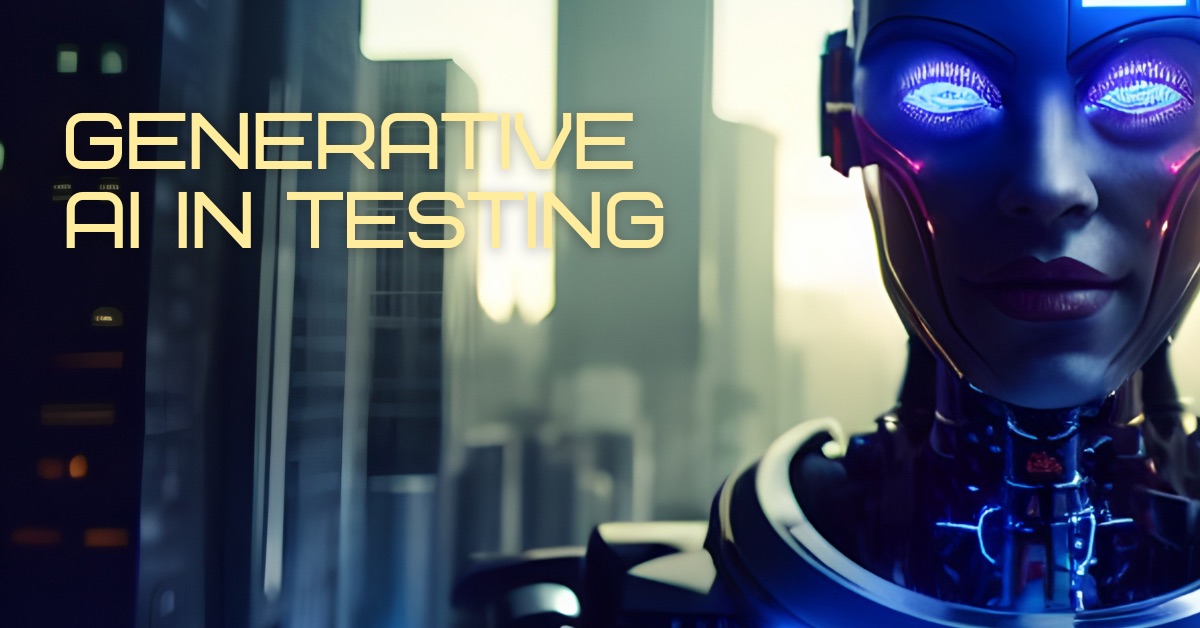In the fast-paced software development world, ensuring the quality of products is paramount. As technology evolves, so do the methods of testing. One of the most exciting developments in recent years is the integration of Generative AI into software testing processes.
Leveraging artificial intelligence can help tech firms test and monitor their software and products and streamline, verify, and improve the quality of critical business processes.
This post explores how Generative AI revolutionizes software testing, its benefits, challenges, and practical implementation strategies.
The Transformation of QA Testing (In Brief)
Software testing has undergone significant transformations over the years, adapting to modern software systems changing needs and complexities. The evolution of QA testing has been a journey spanning from manual testing and scripted automation to data-driven testing, culminating in the emergence of generative AI.
With advanced large language models (LLM) at its core, this transformative technology revolutionizes the testing landscape by delegating most test creation tasks to AI.
Forbes research indicates that AI usage is expected to surge by 37.3% between 2023 and 2030. Despite being in its infancy, AI offers a substantial opportunity, particularly in QA testing. Below is the breakdown of QA testing’s evolution:
1. Manual Testing
In its early stages, QA depended predominantly on manual testing, a method where testers individually examined each software feature for bugs and anomalies, often repeatedly. This approach entailed creating test cases, carrying out these tests, and then documenting and reporting the outcomes.
Although manual testing offered a significant degree of control and provided detailed insights, it was a laborious and time-intensive process fraught with challenges. Notably, it carried a high risk of human error and faced difficulties achieving thorough test coverage.
Related Post: Manual, Automated, and AI QA Testing Comparison
2. Script-based Automation
The desire to boost efficiency, reduce human error, and tackle the testing of intricate systems propelled the industry towards embracing script-based automation. This shift marked a pivotal evolution in QA testing by making it possible to generate consistent, repeatable test scenarios.
Testers wrote scripts that autonomously executed a series of actions, achieving consistency across tests while conserving time and effort. This form of automation significantly enhanced efficiency, streamlining regression testing and speeding up the process.
Despite these clear benefits, including predictability and time savings, script-based automation faced challenges. The meticulous development and maintenance of these scripts required substantial time investment.
Furthermore, this method’s adaptability fell short, struggling to accommodate unexpected changes or variations in testing scenarios, highlighting the ongoing need for innovation in QA testing practices.
3. Data-Driven QA Testing
Data-driven testing revolutionized QA by utilizing datasets to drive test case generation and validation, thereby increasing test coverage and accuracy. This method empowered testers to use data to detect patterns and trends, refining testing strategies for better outcomes.
It addressed scripted automation’s limitations by enabling the input of varied data sets into a single pre-designed test script, facilitating the creation of numerous test scenarios from just one script.
Data-driven testing significantly boosted the versatility and efficiency of testing processes, particularly for applications requiring tests against diverse data sets. However, despite making considerable progress, it wasn’t flawless. The approach still necessitated substantial manual input and struggled to independently adapt to new and dynamic situations in applications’ behavior.
4. Generative AI for QA Testing
Fundamentally, generative AI is a sophisticated AI model that autonomously produces innovative and valuable results, like test cases or data, without direct human guidance. This ability for self-driven innovation significantly broadens the horizons of testing, enabling the creation of tests tailored to specific contexts and greatly diminishing the dependency on manual efforts.
Generative AI represents the next evolution in software testing, leveraging advanced algorithms to autonomously generate test cases, predict potential issues, and optimize testing processes. This cutting-edge technology can further enhance the efficiency and effectiveness of software testing.
Its ability for self-driven innovation significantly broadens the horizons of testing, enabling the creation of tests tailored to specific contexts while reducing the dependency on manual efforts.
Benefits of Generative AI in Software Testing
Generative AI offers a plethora of benefits for software testing, addressing key challenges faced by traditional testing methods:
1. Accelerated Test Case Generation
Generative AI algorithms can rapidly generate diverse and comprehensive test cases, covering several scenarios and edge cases. By automating the test case generation process, generative AI significantly reduces the time and effort required for testing.
2. Enhanced Bug Detection
By simulating various user interactions and system behaviors, Generative AI can uncover subtle bugs and defects that may be challenging to detect through manual or scripted testing. This advanced capability improves bug detection rates and ensures higher software quality.
3. Improved Software Quality
Generative AI’s extensive test coverage and deeper insights into potential issues significantly enhance software quality. By identifying and addressing problems early in the development cycle, Generative AI helps prevent costly defects and improves overall customer satisfaction.
4. Increased Efficiency and Cost Savings
Automating test case generation and execution reduces the time and resources required for testing, leading to cost savings and faster time-to-market. Generative AI also streamlines the testing process, allowing teams to focus on higher-value tasks and innovation.
5. Adaptive Testing Capabilities
Generative AI can adapt to evolving software requirements and environments, continuously improving test coverage and effectiveness. This adaptive capability ensures that testing remains robust and relevant in dynamic development scenarios.
Challenges of Generative AI in Software Testing
While Generative AI offers significant benefits, it also presents several challenges:
1. Data Quality and Diversity
Generative AI algorithms require high-quality and diverse training data to generate accurate and relevant test cases. Ensuring the availability of representative data sets is crucial for the effectiveness of Generative AI in quality assurance testing.
2. Interpretability and Explainability
Understanding and interpreting the results produced by Generative AI models can be challenging, requiring specialized expertise. Testers need to be able to trust and validate the outputs of Generative AI to ensure their accuracy and relevance.
3. Overfitting and Bias
A significant ethical concern in generative AI applications, including QA, revolves around bias. AI models, trained on vast datasets, risk mimicking existing biases within those datasets. In QA, this risk translates to the potential oversight of certain bugs or errors if training data favors specific software types, features, or errors.
Consequently, Generative AI models may suffer from overfitting training data or biased outputs, leading to suboptimal test case generation. Addressing issues related to overfitting and bias requires careful attention to model training and validation processes.
Thus, employing diverse and inclusive training datasets becomes crucial. Additionally, continuously monitoring and adjusting AI models is necessary to prevent them from adopting and acting on biases.
4. Integration Complexity
Integrating Generative AI into existing testing frameworks and workflows can be complex and may require significant modifications. Ensuring seamless integration with other systems is essential to adopting Generative AI in testing environments successfully.
5. Skill Set Requirements
Leveraging Generative AI effectively requires specialized skills and expertise in machine learning, data science, and software testing. Organizations must invest in training and upskilling their teams to utilize Generative AI in QA testing processes effectively.
Companies Benefiting from Generative AI in QA
Generative AI is on track for further progress in 2024. McKinsey predicts that this technology has the potential to contribute up to $4.4 trillion annually across 63 different use cases. However, many businesses have not explored and grasped generative AI’s potential, breadth, and impact.
Numerous companies have successfully implemented Generative AI in their QA processes, realizing significant improvements in efficiency, effectiveness, and software quality.
1. Shoplab
Shoplab excels in streamlining e-commerce operations. With its custom tools, services, and consultancy, it optimizes workflows and operations across various platforms. Leveraging generative AI testing has been transformative for Shoplab, as highlighted in their testimonial:
“We believe this AI testing tool will revolutionize our product development going forward. The time previously allocated to testing is now dedicated to innovation and refining user experience. We are adding new tests every week and receiving suggestions for aspects we hadn’t considered testing before. QA.tech has truly been a game-changer for our engineers.”
2. Leya
Leya is at the forefront of revolutionizing the legal sector with artificial intelligence, harnessing it to aggregate knowledge and streamline legal workflows for enhanced efficiency. The introduction of generative AI testing, exemplified by their use of QA.tech, marks a significant leap forward.
This cutting-edge technology is redefining engineering excellence within Leya, automating and optimizing testing processes. As evidenced by enthusiastic testimonials, Leya recognizes QA.tech as a pivotal innovation, unlocking new potential in automating and refining its operations for the future.
Can Generative AI Integrate with Other Systems?
Generative AI can seamlessly integrate with existing testing frameworks, CI/CD pipelines, and DevOps workflows, enhancing overall efficiency and effectiveness. By incorporating Generative AI into current systems, organizations can tap into its advanced capabilities to refine testing processes and improve software quality.
- Improved Quality Assurance: The fusion of Generative AI with other advanced technologies is transforming the Quality Assurance (QA) landscape, setting new standards for testing efficiency, precision, and scope.
- Amplifying Potential with Reinforcement Learning: Integrating Generative AI with reinforcement learning (RL) significantly boosts its potential. RL teaches an AI system to make decisions through trial and error within its environment, rewarding successful actions and penalizing errors. This model is invaluable for testing complex applications with multiple user interactions and pathways, where traditional ‘right’ or ‘wrong’ testing actions are not straightforward. An RL-enhanced Generative AI system can use its past testing experiences to refine its strategy continuously, thus identifying errors more quickly and accurately.
- Enhancing Visual Testing with Computer Vision: Pairing Generative AI with computer vision technology, which enables AI to process and interpret visual data like humans, offers significant benefits for testing visually intensive applications, such as user interfaces or video games. This synergy allows the AI to recognize and understand graphical elements, and Generative AI uses this data to develop innovative test scenarios. This collaborative approach effectively navigates complex visual testing environments, identifying issues that traditional testing methods might miss.
Will Generative AI Eliminate Human QA Testing Roles?
The rapid integration of generative AI in software testing will lead to significant shifts in job roles and work dynamics within the QA industry. As AI takes over repetitive and mundane tasks, human roles in QA will see substantial changes.
- Evolution of Manual Testing Roles: The demand for manual testers may decrease, or at the very least, their responsibilities will evolve. Manual testers will shift from performing hands-on testing to overseeing and managing AI-driven testing processes. This role change involves ensuring the proper functioning of AI algorithms, interpreting their results, and making informed decisions based on generated data. Additionally, manual testers will collaborate closely with development teams to leverage insights from AI-generated tests for product enhancement.
- Increasing Demand for AI-Skilled QA Professionals: There will also be a rise in demand for QA professionals skilled in AI technology. These experts must grasp generative AI principles and effectively implement them in testing environments. Their duties will include training and fine-tuning AI models, validating their suitability for specific testing scenarios, and troubleshooting any encountered issues.
- Transition to Strategic and Technical Roles: The QA field is transitioning to more strategic, analytical, and technically-oriented roles. This shift highlights the need for upskilling and reskilling initiatives to prepare professionals for an AI-driven future.
- Essential Role of Human QA Testers: Despite the automation capabilities of Generative AI, human QA testers remain vital for designing test strategies, interpreting results, and ensuring software product quality. Generative AI supports human testers by automating routine tasks and providing valuable insights, enabling them to focus on more strategic and high-value activities.
How to Develop a Generative AI QA Strategy for Your B2B Business
Developing a Generative AI QA strategy requires careful planning and consideration of the following steps:
1. Assess Current QA Processes and Challenges
Identify areas where Generative AI can address pain points and improve testing efficiency. Conduct a thorough assessment of current QA processes and identify opportunities for optimization.
2. Evaluate Generative AI Solutions
Research and evaluate Generative AI tools and platforms tailored to your testing requirements. Consider scalability, integration capabilities, and ease of use when evaluating solutions.
3. Pilot Implementation and Testing
Start with small-scale pilots to assess the feasibility and effectiveness of Generative AI in your QA processes. Conduct pilot implementations in controlled environments to evaluate the performance of Generative AI models and identify any potential challenges or limitations.
4. Training and Upskilling
Provide training and upskilling opportunities for your QA team to familiarize them with Generative AI technologies and best practices. Ensure your team has the necessary skills and expertise to leverage Generative AI in QA testing processes effectively.
5. Continuous Improvement and Monitoring
Continuously monitor and evaluate the performance of Generative AI models, iterating and refining your QA strategy over time. Collect feedback from users and stakeholders to identify and implement changes where necessary.
Conclusion
Generative AI has the potential to transform software testing, offering unparalleled capabilities in test case generation, bug detection, and software quality enhancement. By embracing Generative AI, organizations can streamline their testing processes, improve software quality, and stay ahead in today’s competitive market landscape.
As CTOs, software developers, and QA engineers, it’s essential to explore and harness the power of Generative AI to drive innovation and success in software testing.
Is your company looking to outsource QA testing for crucial product development initiatives? QA.tech offers an AI-powered solution for autonomous QA testing, enabling your development team to concentrate on their primary responsibilities while reducing bug-related distractions and providing immediate feedback. Try QA.tech today to improve your development workflow.



